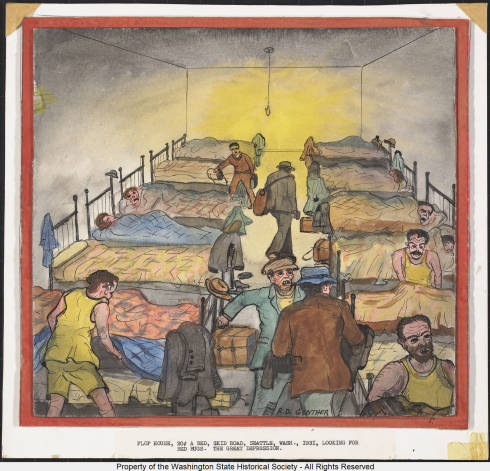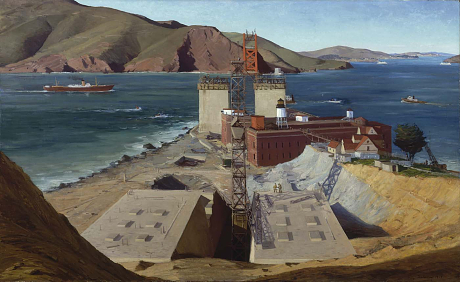While it is most certainly a dark period in American history, the Great Depression, and the New Deal that it spawned, were very good for American art. Through the struggle of people art is so often recreated in new and more relatable ways. This was certainly the case in the Great Depression, when artists were forced to look around them at a world where things seemed to be crumbling.
This was certainly the case for artist Ronald Debs “Ray” Ginther, who was known for his gritty watercolor paintings that portrayed the struggle of working people thrown into abject poverty by the Great Depression. Ginther painted in Washington and Oregon, and his portrayal of life in Seattle in the 1930’s is evocative in it’s down and dirty simplicity.

The angst and pain portrayed on the faces on the people in Ginther’s paintings speaks volumes on the realities of daily life in America during the depression. Those out of work slept in flop houses where they were available, as well as in shanty towns and on the raail system. Ginther’s pieces are desperation in watercolor, and are stunning and raw images of the human face of the nation during this period. While I typically gravitate towards photography from this era, as many do, there is some magic in Ginther’s watercolor perspective.
Moving through and out of the Great Depression Roosevelt’s New Deal breathed life into public works across the country, improving infrastructure and creating jobs for the destitute. This included artists, who have “got to eat just like other people” as stated by Harry Hopkins, head of the work relief program within the New Deal(Adler, 2009). These artists were not restricted in their subject matter, and so many of them painted what they knew, the everyday life around them in all of it’s forms. One such artist was Los Angeles’ Millard Sheets.

Sheets painted close to home, in the case of Angel’s Flight, even using his own wife as his model(LACMA). IN this particular painting Sheets uses view from the top of the hill to show the complete scene in this neighborhood. The bright colors of the houses on the top of the hill give way to darker, less distinct images of the workers climbing the hill on the right of the painting. This is an excellent example of the scenes that must have played out in ordinary neighborhoods everyday during the depression, with those fortunate enough to have maintained employment living alongside those who had lost so much and struggling to live.
As the New Deal’s public works progressed, so did the optimism in the paintings that New Deal artists were creating.

Ray Strong was a works project artist who painted in the San Francisco, California area and focused mainly on industrial landscapes. One such painting is Golden Gate Bridge, an oil painting featuring the iconic bridge while it is under construction. This painting was selected by President Roosevelt to hang in the White House as a symbol of the hope of a new era and as a tribute to American engineering(SAAM). Considering the extremely grim daily life of so many Americans in the 1930’s, painting like this one were a scene of progress and hope. The manpower behind this symbolism meant that people were working hard to pull the nation out of dark times. It is a wonder that the New Deal included artists to document this time in our history.
References
The Great Depression in Washington State Project. “Ronald Ginther Watercolors“. nd. Web, 27 March 2016
Adler, Jerry. “The Art of the New Deal” Smithsonian Magazine, June 2009. Web, 27 March 2016
LACMA. “Angel’s Flight”. nd. Web, 27 March 2016
Smithsonian American Art Museum. “Golden Gate Bridge, Exhibition Label“. Smithsonian Institution. nd. Web, 27 March 2016
Thanks so much – great piece.
LikeLike
I enjoyed reading your blog, it seems we had similar views on the subject of The Great Depression. I too included Ronald Ginther, he was my main focus. His work was simply amazing, the expressions he portrayed on the faces in his paintings were so full of desperation and emotion. I can feel what they are feeling when I look at their faces. Isn’t that the point? Art is to make us feel and to make us see something. I certainly felt something when looking at his paintings. The painting of The Golden Gate Bridge was something I had never seen before. It’s amazing to think that such a landmark was built at such a low time in American history. I have never seen any other paintings by Ray Strong, but this one is great. The way he paints is like you are seeing it for yourself. It’s like looking at a point in time and actually feeling like you were there. Again, great job!
LikeLike
I too enjoyed how you highlighted the unbroken human spirit. I also enjoyed the “layout” of your blog, the images seemed to display an increase of societal wellness as I read further down the blog. Tax dollars during Roosevelt’s term was also used to fund artists which also allowed many people to see an original piece of art for the first time in their lives. I feel that is what really makes your selection of paintings noticeable, people were reflecting on their own lives and experiences through art and while each person during the era went through similar struggles, not all of them shared the same experiences.
Source: https://www.archives.gov/exhibits/new_deal_for_the_arts/#
LikeLike
I love the evolution of the Great Depression you convey with your blog. It starts with a decidedly downer piece and end with glorifying infrastructure of a country rebuilding. My favorite of the three pieces was the second. The busy city scape with it sharp angles really called to me. My least favorite of the three was the watercolor, primarily due to its depressing depiction of the citizens. I understand that this was a dark time but I appreciate it when painters portray optimism in there paintings. All the images displayed in this blog have very distinct styles, attached below is a link to some of the biggest artistic styles that appeared during this era.
http://www.visual-arts-cork.com/modern-art-movements.htm
LikeLike
You really choose a topic that could have been full of misery, but you really showed the grace of the unbroken human spirit. The paintings you chose are a wonderful depiction of portraying the real life struggles but with the hope and promise of better days ahead. I love watercolors, they always have a dream world state to them, and Ginther’s painting is almost that last thought between dream and awake. It is really beautiful how it shows the resignation that person has to their fate, but also shows the solace and comfort they have with those that are there in the trenches with them….
LikeLike
The Great Depression was tough on everyone and it allowed painters to recreate what they experienced and what they saw into a painting. Some of the paintings during this time really reflected the hardship and struggles, like the image you chose by Ray Ginther. President Roosevelt also encouraged artists to draw images of Rural America and to the portray the American people as people who would be persevere. Roosevelt also bought paintings during this time from artists for top dollar to help push along this type of art. He wanted to use this art as propaganda to show the country that it would come out of this slump into prosperity. Anyhow, I love the displays you chose and how you were able to portray a different variety of artistic styles during this time.
LikeLike
I really enjoyed the progression of the pieces you have chosen. You can see the movement through the Great Depression and into the New Deal era. Sheets’ work is by far my favorite of the three. I first see the geometric shapes of the different roof tops then the women in the fore front. I also like that use of multiple flights of stairs and shadowing so you can’t really see where the painting ends in terms of the ground. Another of his works, Tenement Flats he does similar work with the color and stair case theme. Your eye doesn’t really know where to rest and bounces around the painting. Here is the link if you want to view it!
http://americanart.si.edu/collections/search/artwork/?id=22262
LikeLike
I think you chose a really great topic with the great depression and the art it produced and the artist Ray Strong and Ginther. I really like his paintings showing the grey and dreary of Ginthers Flop House with the small amount of light illuminating the room, which shows dark times. Ray Strong made paintings of industrial building and bridges being built and was hung in the Roosevelts White House, which I thought was really cool because it showed hope. Those two painting really captured the great depression with one showing how bad it was and relating to people and the other showing the hopeful side that it wasn’t the end.
http://www.history.com/topics/great-depression
LikeLike
I really enjoy your post. I also did my exhibit on the Great Depression. What I really enjoyed about your exhibit was your choice of art. All three of those pieces I have never seen before. Flop House, the watercolor and ink painting really hit me hard. Putting that painting as your first picture in your exhibit was genius; it gives the reader an instant visualization of what you are trying to explain. I like how you mention that most people gravitate towards photography from this era. You should check out a photograph named Migrant Mother. It was taken during the Great Depression and it is so moving. Great job with your exhibit. All of your art fits so well and it all correlates wonderfully with the Great Depression.
LikeLike
I really enjoyed each of the pieces you included in your virtual exhibit. Your first piece, Flop House, really portrays the harsh conditions during the Great Depression. It’s truly sad to think that individuals without work were living in such conditions. The shift in art as the New Deal came about is truly inspiring. The piece, Golden Gate Bridge, really created a sense of optimism for viewers. It showed individuals that better things were to come and the nation would triumph through this difficult period. Great blog!
LikeLike
I really enjoyed the art pieces you chose, especially Angel’s Flight. As I look at it, I get the impression of a hot summer evening; two women out on the balcony hoping to catch a breeze. The colors are vibrant and made me say “wow” when I first saw it. I am so very glad that I did not live in that era. It seemed so sad and desperate. Thank you for your blog.
LikeLike